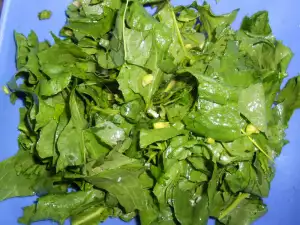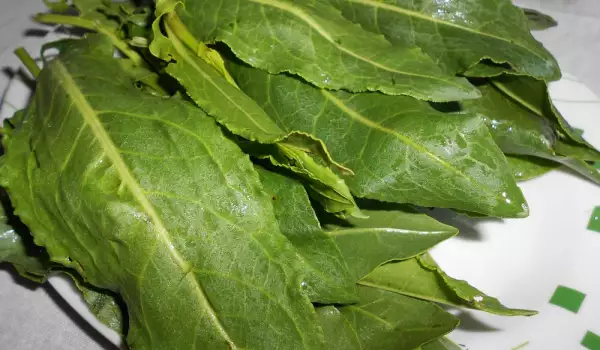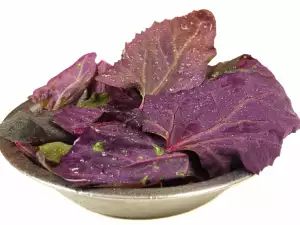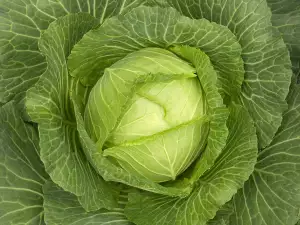Sorrel is a perennial plant with fleshy fusiform roots. It is of the Rumex genus, and its Latin name is Rumex acetosa. Sorrel grows abundantly in meadows in most of Europe and isseen as a leaf vegetable. In Europe, Asia, America and Africa, sorrel is also used, mainly in wild forms. Sorrel varieties differ mainly in the color of their leaves.
The leaves are oblong and 7-15 cm long, somewhat sagittated at the base, with very long handles. The upper leaves are without stems and are often dark red. Ordinary sorrel has dark green leaves and stems, while Lyons sorrel has large, fleshy, dark green, broadly ovate leaves. Mycopski sorrel is with large green leaves. Local sorrel has pale green leaves that often have a reddish pigment under the influence of low temperatures and the autumn.
Sorrel was brought to Europe from Asia. By being grown in all countries of Europe and North America many varieties have been bred. It was one of the earliest spring vegetables. Use fresh leaves for salads, soups, puree, garnish and seasoning in canned vegetables.
Composition of sorrel
Sorrel is very rich in vitamins (C, B1, B2, PP, carotene), proteins, mineral salts, potassium, iron, magnesium and phosphorus, malic, citric and succinic acids. The plant contains oxalic acid, which contributes to its characteristic taste. 100 g of sorrel has only 21 calories.

Selection and storage of sorrel
Choose fresh sorrel, which has a nice green color with no stains or traces of decay. You can store sorrel and spinach and rhubarb, frozen. In this case wash the vegetables well, dry and then cut them, order in plastic bags or buckets and store in a cold freezer.
Another way to preserve the freshness of sorrel for a long time, is canned. For this purpose, boil water, dip the green leafy vegetables in it for 2-3 minutes and drain well. Once cooled down, organize it into jars, cover up with caps and sterilize.
Culinary uses of sorrel
Sorrel is a leafy green vegetable that does not tolerate very long cooking - satisfactory are a few minutes stewing in a little olive oil or butter. To get the most flavor, roll the leaves into a nicely tight roll, then slice them thinly with a sharp knife.
Sorrel leaves have a pleasant sour-bitter taste. If you cut them in small pieces, you can add sorrel in salads, soups and herb sauces. The leaves are added to salads to enhance the flavor. Often pureed in soups and sauces, they are an essential ingredient in sorrel soup. Dishes with spinach and potato soup yield a pleasant taste after adding sorrel.
It is often a very good addition to sandwiches and lamb, cooked with sorrel can fascinate you. Because of its taste, some argue that it quenches thirst and is considered useful for increasing appetite.
Sorrel is prepared like spinach. You can add it to spinach, chopped - to forge a green salad, add it to potato soup, etc. Quite popular is sorrel soup, which is a classic in many European traditions. In addition to flavoring soups and dishes it is used in the preparation of special sauce to flavor meat and fish, which today is offered in good restaurants and fine dining places. Sorrel sauce with cream is a traditional addition to hard-boiled eggs and river fish.

Sorrel soup (cold)
Yogurt - 500 ml
butter – 50 g
Sorrel - 1 bunch
dock - two bunches, can use
Garlic - 3 sprigs fresh
Fennel - 2-3 sprigs
nuts - 100 g chopped
salt
black pepper
Preparation: Prewash the green leafy vegetables and put them in a pot of boiling water to boil gently for about 5 minutes. With a slotted spoon remove the sorrel and dock and allow them to drain. Heat the butter in a pan and fry the finely chopped garlic and set aside some of the green part. After a while, add chopped sorrel, fry briefly, while stirring and remove from the container to cool. Beat yogurt well with little water to make a thick mixture. Mix the yogurt with the sorrel and finely crushed fresh garlic. Season with spices and serve the sorrel soup with crushed walnuts.
Benefits of sorrel
Sorrel, along with their relatives spinach and rhubarb, can provide a lot of health benefits to our body. Sorrel has a homeopathic anti-inflammatory effect, improves appetite. From the leaves is prepared tea that helps with problems with the liver and kidneys.

In ancient times, they believed that it improves digestion and serves as a good antiscorbutic agent. In folk medicine, a decoction of sorrel leaves is assumed to help with disorders of the stomach and a remedy for jaundice and other diseases of the liver. In food, these leaves are used in cooked and raw (salads) states. It may be canned.
Dangers of sorrel
Sorrel contains very large amounts of oxalic acid, which robs our body of calcium. Oxalic acid can lead to joint pain and kidney issues, in children it can lead to stunting.
This automatically makes sorrels contraindicated for consumption by people with rheumatic complaints, kidney or bladder stones, etc. Sorrel is also a laxative agent. Sorrel is not recommended in violation of the salt exchange with inflammatory bowel disease and tuberculosis.
It should not be consumed by people suffering from kidney stones, rheumatism or arthritis, so it is not recommended for the elderly.






















